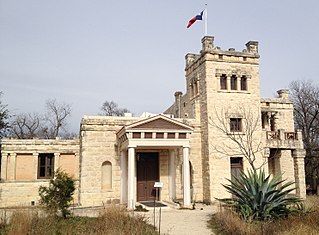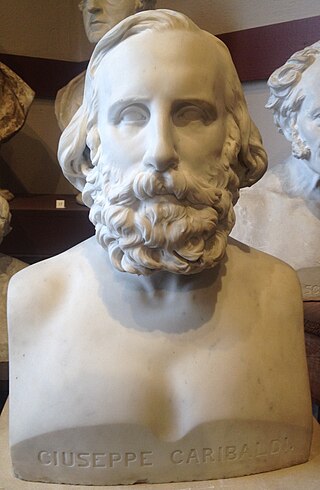
The National Statuary Hall is a chamber in the United States Capitol devoted to sculptures of prominent Americans. The hall, also known as the Old Hall of the House, is a large, two-story, semicircular room with a second story gallery along the curved perimeter. It is located immediately south of the Rotunda. The meeting place of the U.S. House of Representatives for nearly 50 years (1807–1857), after a few years of disuse it was repurposed as a statuary hall in 1864; this is when the National Statuary Hall Collection was established. By 1933, the collection had outgrown this single room, and a number of statues are placed elsewhere within the Capitol.

Frederick Wellington Ruckstull was a French-born American sculptor and art critic.

Jo Davidson was an American sculptor. Although he specialized in realistic, intense portrait busts, Davidson did not require his subjects to formally pose for him; rather, he observed and spoke with them. He worked primarily with clay, while the final products were typically cast in terra-cotta or bronze, or carved from marble.

Franzisca Bernadina Wilhelmina Elisabeth Ney was a German-American sculptor who spent the first half of her life and career in Europe, producing portraits of famous leaders such as Otto von Bismarck, Giuseppe Garibaldi and King George V of Hanover. At age 39, she immigrated to Texas with her husband, Edmund Montgomery, and became a pioneer in the development of art there. Among her most famous works during her Texas period were life-size marble figures of Sam Houston and Stephen F. Austin, commissions for the Texas State Capitol. A large group of her works are housed in the Elisabet Ney Museum, located in her home and studio in Austin. Other works can be found in the United States Capitol, the Smithsonian American Art Museum, and numerous collections in Germany.

Pompeo Luigi Coppini was an Italian born American sculptor. Although his works can be found in Italy, Mexico and a number of U.S. states, the majority of his work can be found in Texas. He is particularly famous for the Alamo Plaza work, Spirit of Sacrifice, a.k.a. The Alamo Cenotaph, as well as numerous statues honoring Texan figures, such as Lawrence Sullivan Ross, the fourth President of Texas A&M University.

The Elisabet Ney Museum is a museum located in Austin, Texas, United States. It is housed in the former studio of sculptor Elisabet Ney and is dedicated to showcasing her life and works. There is a permanent collection of her portrait busts and personal memorabilia on display.

The United States Capitol building features a central rotunda below the Capitol dome. Built between 1818 and 1824, the rotunda has been described as the Capitol's "symbolic and physical heart".

Sam Houston is a statue of Sam Houston by Elisabet Ney, originally modeled in 1892.

Lady Macbeth is a statue of the Shakespearean character Lady Macbeth by German American sculptor Elisabet Ney. The sculpture is a life-size full-length female figure rendered in marble. Completed in 1905, Lady Macbeth is one of Ney's last works and was regarded by the artist as her masterpiece. It is housed in Washington, D.C., in the Luce Foundation Center for American Art at the Smithsonian American Art Museum, which acquired the piece in 1998.

Albert Sidney Johnston is a memorial statue of General Albert Sidney Johnston by German American sculptor Elisabet Ney. The piece is a life-size recumbent male figure rendered in marble sculpture. It depicts the General at the time of his death in the Battle of Shiloh during the American Civil War. Completed in 1903, the piece resides atop Johnston's tomb in the Texas State Cemetery in Austin, Texas, where it was installed in 1905.

James Paul Clarke is a marble sculpture depicting the American politician of the same name by Pompeo Coppini, installed in the United States Capitol's National Statuary Hall Collection, in Washington, D.C., as one of two statues gifted by the U.S. state of Arkansas. The 6 foot 10 inch tall statue was placed in the Hall in 1921. The work cost $7,500. and was unveiled in Washington in 1921. In 2024, the statue was removed and replaced with a statue of Johnny Cash.

Arthur Schopenhauer is a sculpture of German philosopher Arthur Schopenhauer by sculptor Elisabet Ney. Completed in 1859, the piece is a portrait bust rendered in marble. The bust was modeled and carved in Germany, but it is now held by the Elisabet Ney Museum in Austin, Texas, United States.

Brigham Young is a marble statue by Mahonri Young representing the Mormon religious leader of the same name, installed in the United States Capitol, in Washington D.C., as part of the National Statuary Hall Collection. It is one of two statues donated by the state of Utah, and is unusual in the collection in that Young is portrayed sitting down. The statue was unveiled by Alben William Barkley on June 1, 1950.

Ludwig II is a sculpture of King Ludwig II of Bavaria by sculptor Elisabet Ney. Completed in 1870, the piece is a portrait statue rendered in plaster. The statue was modeled and carved in Germany, but it is now held by the Elisabet Ney Museum in Austin, Texas; a marble version, completed by another sculptor, is installed in the Herrenchiemsee Palace in Bavaria.

Giuseppe Garibaldi is a sculpture of Italian revolutionary Giuseppe Garibaldi by German sculptor Elisabet Ney. Completed in 1866, the piece is a portrait bust rendered in marble. The portrait was modeled and carved in Italy, but it is now held by the Elisabet Ney Museum in Austin, Texas.

Robert R. Livingston is an 1875 bronze sculpture of Robert R. Livingston, one of the Founding Fathers of the United States, executed by the New York born sculptor Erastus Dow Palmer. The state is installed in the United States Capitol, in Washington, D.C., as part of the National Statuary Hall Collection. It is one of two statues donated by the state of New York.

Crawford Long is a 1926 marble sculpture depicting the American surgeon and pharmacist of the same name by J. Massey Rhind, installed in the United States Capitol, in Washington, D.C., as part of the National Statuary Hall Collection. It is one of two statues donated by the U.S. state of Georgia.

Roger Sherman is an 1872 marble sculpture of Roger Sherman by Chauncey Ives, installed in the United States Capitol, in Washington, D.C., as part of the National Statuary Hall Collection. It is one of two statues donated by the state of Connecticut. The sculpture was unveiled by Senator Orris Sanford Ferry of Connecticut on March 8, 1872.

Jonathan Trumbull is an 1872 marble sculpture of Jonathan Trumbull by Chauncey Ives, installed in the United States Capitol, in Washington, D.C., as part of the National Statuary Hall Collection. It is one of two statues donated by the state of Connecticut. The sculpture was unveiled by Senator William Alfred Buckingham of Connecticut on March 8, 1872.




















